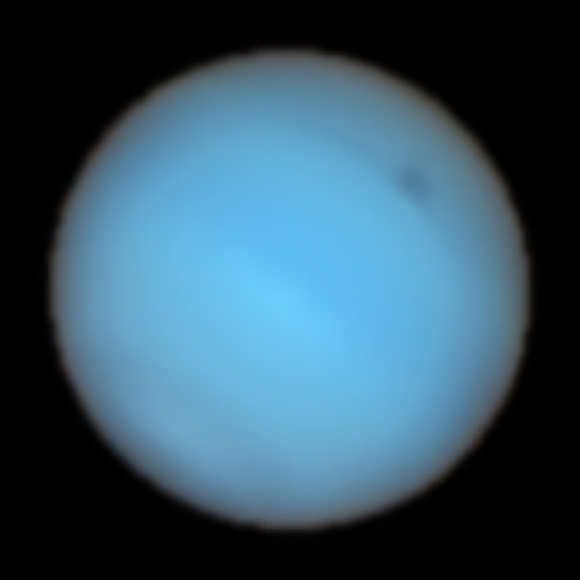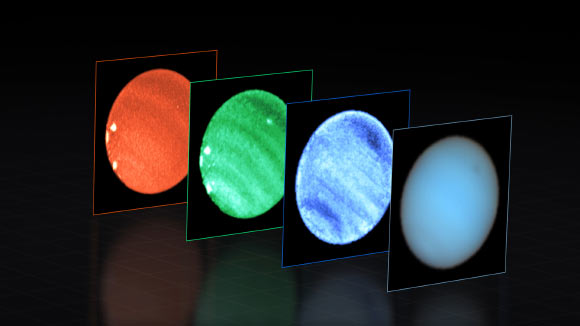Astronomers using the Multi Unit Spectroscopic Explorer (MUSE) instrument on ESO’s Very Large Telescope (VLT) have observed a large dark spot in Neptune’s atmosphere, with an unexpected smaller bright spot adjacent to it. This is the first time a Neptunian dark spot has ever been observed with a ground-based telescope.

This image from the MUSE instrument on ESO’s Very Large Telescope shows Neptune; a dark spot can be seen to the upper-right. Image credit: ESO / Irwin et al.
Large spots are common features in the atmospheres of giant planets, the most famous being the Great Red Spot on Jupiter.
On Neptune, a dark spot was first discovered by NASA’s Voyager 2 in 1989, before disappearing a few years later.
“Since the first discovery of a dark spot, I’ve always wondered what these short-lived and elusive dark features are,” said University of Oxford’s Professor Patrick Irwin.
In the new research, Professor Irwin and colleagues ruled out the possibility that dark spots are caused by a ‘clearing’ in the clouds.
Their new observations indicate instead that dark spots are likely the result of air particles darkening in a layer below the main visible haze layer, as ices and hazes mix in Neptune’s atmosphere.
Coming to this conclusion was no easy feat because dark spots are not permanent features of Neptune’s atmosphere and astronomers had never before been able to study them in sufficient detail.
The opportunity came after the NASA/ESA Hubble Space Telescope discovered several dark spots in Neptune’s atmosphere, including one in the planet’s northern hemisphere first noticed in 2018.
Using data from the MUSE instrument on VLT, the astronomers were able to split reflected sunlight from Neptune and its spot into its component colors, or wavelengths, and obtain a 3D spectrum. This meant they could study the spot in more detail than was possible before.
“I’m absolutely thrilled to have been able to not only make the first detection of a dark spot from the ground, but also record for the very first time a reflection spectrum of such a feature,” Professor Irwin said.

This image shows Neptune observed with the MUSE instrument on ESO’s Very Large Telescope. At each pixel within Neptune, MUSE splits the incoming light into its constituent colors or wavelengths. This is similar to obtaining images at thousands of different wavelengths all at once, which provides a wealth of valuable information to astronomers. The dark spot is most prominent at shorter (bluer) wavelengths. Right next to this dark spot MUSE also captured a small bright one, seen here only in the middle image at 831 nm and located deep in the atmosphere. This type of deep bright cloud had never been identified before on the planet. The images also show several other shallower bright spots towards the bottom-left edge of Neptune, seen at long wavelengths. Image credit: ESO / Irwin et al.
Since different wavelengths probe different depths in Neptune’s atmosphere, having a spectrum enabled astronomers to better determine the height at which the dark spot sits in the planet’s atmosphere.
The spectrum also provided information on the chemical composition of the different layers of the atmosphere, which gave the team clues as to why the spot appeared dark.
“The observations also offered up a surprise result. In the process we discovered a rare deep bright cloud type that had never been identified before, even from space,” said Dr. Michael Wong, a researcher at the University of California, Berkeley.
“This rare cloud type appeared as a bright spot right beside the larger main dark spot, the VLT data showing that the new ‘deep bright cloud’ was at the same level in the atmosphere as the main dark spot.”
“This means it is a completely new type of feature compared to the small ‘companion’ clouds of high-altitude methane ice that have been previously observed.”
A paper on the findings appears in the journal Nature Astronomy.
_____
P.G.J. Irwin et al. Spectral determination of the colour and vertical structure of dark spots in Neptune’s atmosphere. Nat Astron, published online August 24, 2023; doi: 10.1038/s41550-023-02047-0







